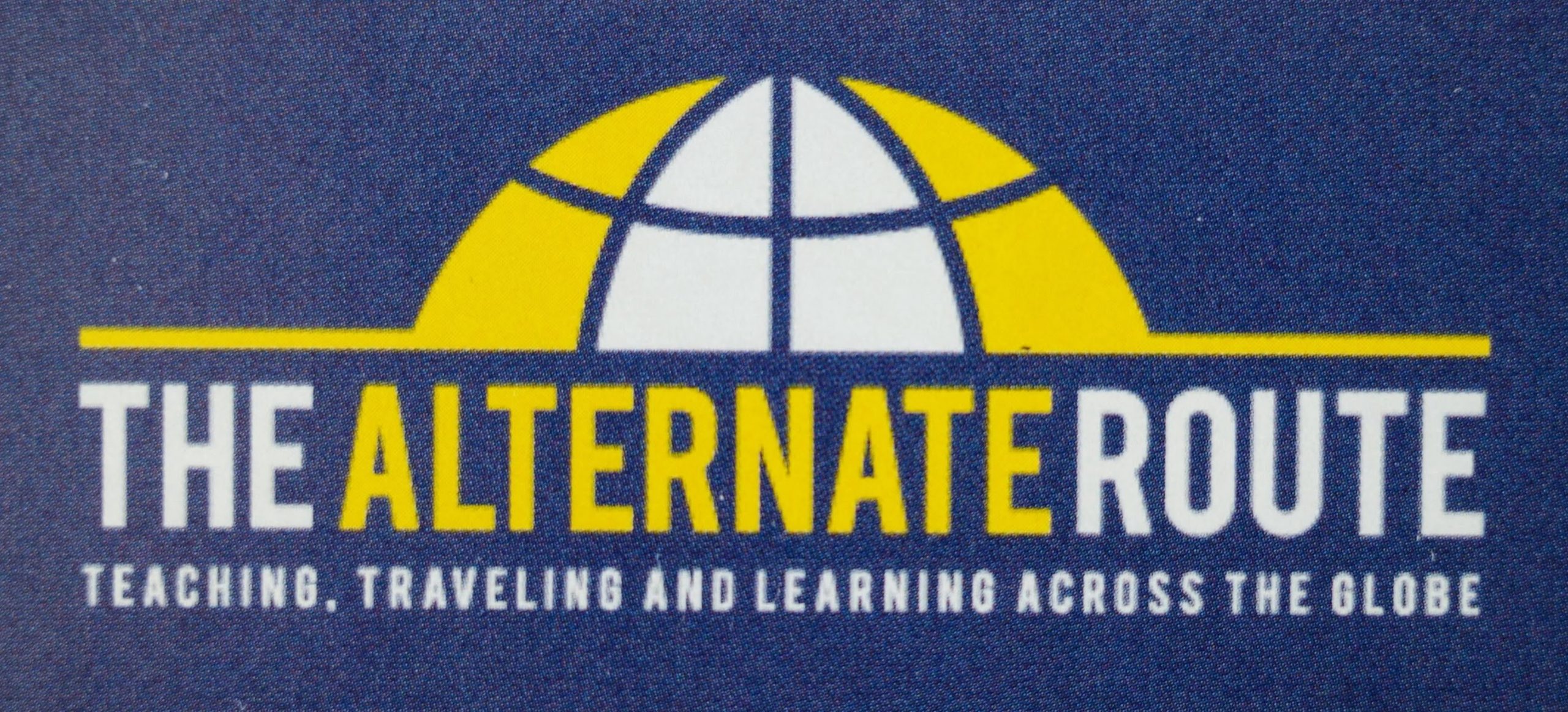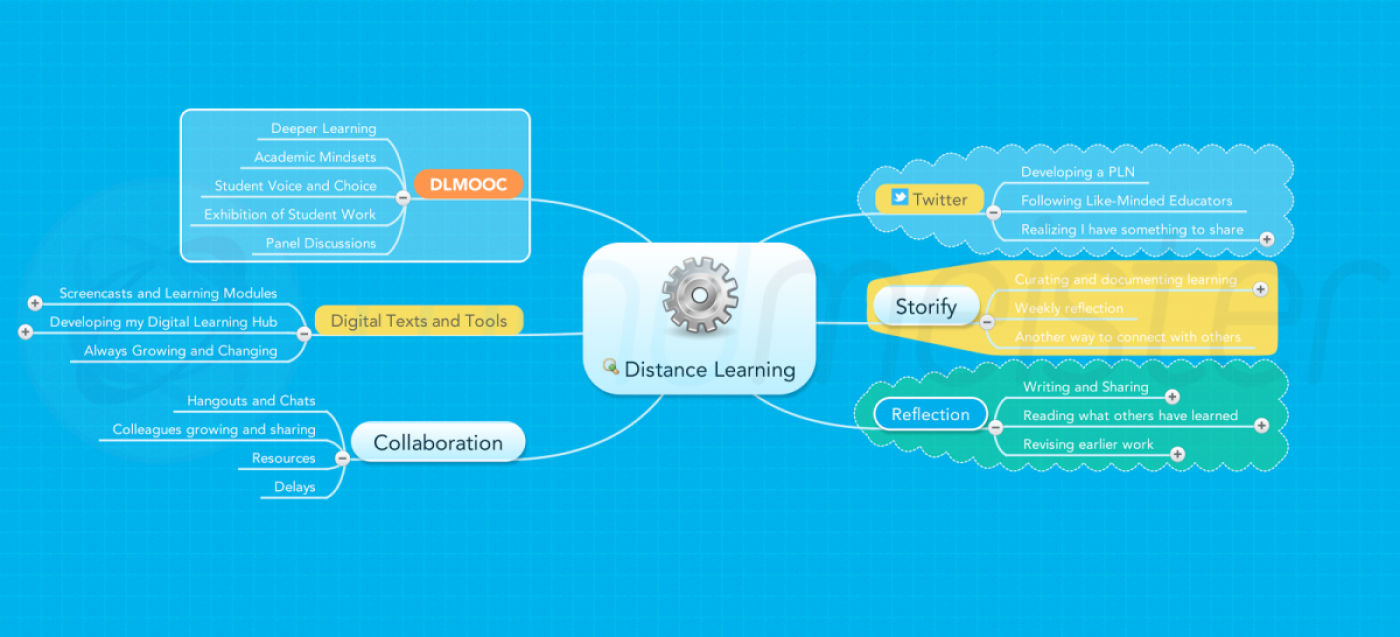The title of the course I took this semester, Distance Learning, does not do it justice. When I first heard the title, I imagined learning about online tools to help teachers and students learn. While I have learned of many new digital tools, the course was so much more than that. This mindmap shows how extensive and deep the content of this course was.
When I reflect on what I have learned this semester, I immediately think of the connections I have made with others through the DLMOOC and Twitter. In January, I started out hesitantly on Twitter. This was my third time in several years that I tried to catch the Twitter fever. My first two attempts fizzled out. This time, however, I am hooked. I have chosen specific people to follow based on my interactions with them in the DLMOOC, and have followed even more based on who these people are following. I have mostly posted what I had to post for assignments, but I think that is mostly due to not having much time outside of school and my coursework. I am definitely going through the stages I have heard others before me describe. After being overwhelmed by the number of tweets to read every day, I am learning to skim and scan. This is hard, but I am getting better at it. I also have figured out a system of saving tweets and resources to Evernote so that I can access them at a later time. I have been doing more lurking than contributing at this point, but I do retweet and am getting to “know” other educators through Twitter.
The DLMOOC and Storify helped me to get the most out of Twitter. I connected with teachers like Joy Kirr on the MOOC, who shared fantastic resources for seventh grade language arts. She has created Google Docs that she invites fellow seventh grade teachers to add to. The documents contain suggested books for read aloud, teaching ideas and more. Since I started following Joy, I noticed many of her tweets were about Genius Hour. Although I have had students work on independent projects of choice before, I had no idea there was a world of teachers out there devoted to Genius Hour. By following #geniushour, I have received daily updates of teachers who are trying it out in their classrooms for the first time. They are sharing successes, failures, student work, questions and resources. I am gathering information that will help me implement genius hour next year in my classroom.
One thing I’ve learned on Twitter is that no one is an expert. Everyone has questions and wants to learn more. Everyone encourages others to share. This community is invigorating and inspiring. Besides building a professional learning network on Twitter, I have been developing my digital learning hub this semester. I feel like it is finally a hub as the sidebar keeps growing. My students use it almost daily. I created a LiveBinder with all of the materials they will need for the argumentative writing unit we are in the midst of. I have also expanded the Home Reading section of the site, and will continue to add more. I have posted examples of student work, including GoAnimate videos the students worked on last semester.
The biggest area of growth on my learning hub has been in the Teacher section. I now have resources there that I am sharing with other teachers. I have added the Edmodo tutorial that includes screenshots and a screencast for teachers starting out on Edmodo. I have also added the Copyright Learning Module that my colleague Nancy Atterberry and I worked on this semester. This learning module is an extensive unit that teachers can use with minimal preparation. It focuses on copyright, fair use, public domain, Creative Commons and how to give proper attribution for digital content. I am looking forward to teaching this module to my students next month. Finally, I have added a unit plan that I worked on for my other class this semester, Global Literacies. The unit is called Multicultural Perspectives and Stereotypes. Although I will not teach this until the fall, I am ready to share it with other teachers and am happy to have the materials for the unit already posted to my website. I am excited that my learning hub is growing and know it will continue to expand.
Moving forward, there are several goals I have in mind, as outlined in the chart below. These goals will help me use technology to become a blended educator and more effective teacher.
| Area | Goals |
| Don’t stop! Keep expanding my PLN by following others. Start sharing more on Twitter. Keep working on ways to manage the constant stream of information. Take a break every now and then. Find teaching ideas that don’t need technology. Lots of teachers are sharing great ideas for active and engaging learning. Seek out people on Twitter who I might disagree with. Be open to new ideas; be ready to defend my own beliefs. | |
| Digital Learning Hub | For every unit I teach moving forward, put more and more digital content online. Direct my students to the hub for each unit I teach. Keep developing the teacher section. |
| Teaching Practices | Incorporate more authentic learning tasks into each unit. Make sure students always know “why we are doing this.” Make sure the answer connects to the real world. Connect with other schools on a regular basis. For example, when we read multicultural books, students should be connecting with others in the cultures they are reading about. Plan an ongoing Genius Hour project for next year. Incorporate more student voice and choice into my classroom. Student blogs. I never did get to blogging with students this year, but now that I have a lot of other things in place, I think I can start it next year. I want student blogs to be a reflection on learning, a place for book discussions, and a way to connect with other schools. Explore the idea of exhibition of student work and/or portfolio defense. Have students redo work until they achieve the standard. Stay connected with the DLMOOC Community. |
| Tech Tools | Expand my use of Edmodo. Currently I am using it primarily for quizzes, but I know there is more that can be done with it. Make more LiveBinders. This is a great way to store and organize information for students. Create LiveBinders for other units of study. Explore the idea of a class Twitter account? Rap Genius: Start using this as soon as possible. Look into other digital text annotation tools such as NowComment. Always keep an eye open for new tools to use in the classroom. |
This already seems like an ambitious list, but I am sure it will keep growing. The nice thing about being a “connected” teacher is that I can get help with any one of these goals by checking in on Twitter and even expanding my PLN. I may get overwhelmed, but I will not be alone.

